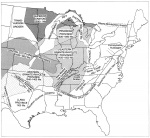Southern Indiana Arm
Location
See text below and figure 5

References
Braile et al. 1982, 1984, Sexton et al. 1986
Description
The researchers above postulated the existence of a buried extension of the Reelfoot Rift northeastward into Indiana and possibly southeastemmost Illinois. They called this proposed extension the Southern Indiana Arm or Rift. As proposed, the Southern Indiana Arm would form a triple (or quadruple) junction with the well established Reelfoot Rift, Rough Creek Graben, and the hypothetical St. Louis Arm. Collectively, these structures are sometimes referred to as the New Madrid Rift Complex.
Braile et al. (1982) based their interpretation of the Southern Indiana Arm on patterns of gravity and magnetic anomalies and on an apparent slight concentration of earthquake epicenters along the Wabash River. Braile et al. (1984) and Sexton et al. (1986) published two seismic reflection profiles: one runs eastward across southern Hamilton and White Counties, Illinois; the other follows the north border of White County and continues into Gibson County, Indiana. These profiles were interpreted as showing layered rocks cut by large normal faults beneath the normal Paleozoic succession. The "Grayville Graben," a downfaulted block near Grayville, Illinois, was interpreted from the northern seismic profile. Several faults of the Wabash Valley Fault System offset Paleozoic reflectors on the seismic sections. Some of the Paleozoic faults appear to line up with inferred deeper faults, but no direct connection is seen.
A COCORP seismic profile (Pratt et al. 1989) does not substantiate the existence of a rift in the Wabash Valley region. Also, several sets of proprietary seismic reflection profiles that I have viewed fail to substantiate a northeastern extension of the Reelfoot Rift into Indiana. These seismic profiles display sets of prominent but discontinuous reflections below the normal Paleozoic succession, as seen on the profiles of Braile et al. (1984) and Sexton et al. (1986) . These intrabasement reflectors extend as deep as 5 seconds two-way travel time, corresponding to a depth of approximately 35,000 feet (11 km) in parts of southeastern Illinois and southwestern Indiana. Intra basement reflectors also appear on some profiles far west of the proposed Southern Indiana Arm. The deep reflectors, in places, appear to be slightly tilted, but no faults were interpreted by oil company geophysicists. Apparent angular discordance is shown between the intrabasement reflectors and the lowest Paleozoic reflectors on some sections.
The nature of the intrabasement reflectors is open to speculation. They may represent a Precambrian terrane older than and unrelated to the New Madrid Rift Complex (Pratt et al. 1989). More drilling and geophysical information are needed to define deep structural relations in this region. Use of the name Southern Indiana Arm, however, should be discontinued.
See also REELFOOT RIFT, ROUGH CREEK GRABEN, ST. LOUIS ARM (discarded).
